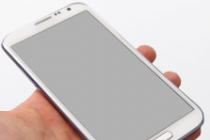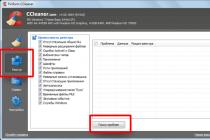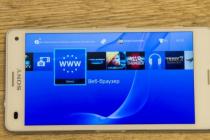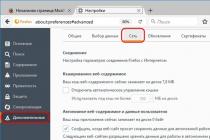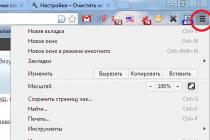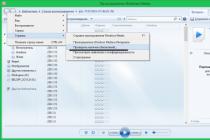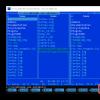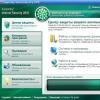A little about batteries
Laptop battery. Accumulator battery (other names: battery, battery) - this is one of the main devices that distinguish a laptop from a desktop machine, although this does not affect the operation of the laptop as such, but still everyone wants to have a working battery, at least for the sake of not turning off the laptop go from room to kitchen.
Let's see what kind of batteries are in principle:
NICKEL-CADMIUM BATTERY - (or abbreviated NiCd) nickel-cadmium;
NICKEL METAL-HYDRIDE BATTERY - (or abbreviated NiMH) nickel-metal hydride;
LITHIUM ION BATTERY - (or Li-ion for short) lithium-ion batteries.
The latter are the most common, and it is believed that these are the most best batteries... Is it so?
The technology for making alkaline nickel batteries was proposed in 1899, but the first NiCd battery appeared in 1947. At one time, these batteries were really almost the only ones. The emergence of batteries newer in terms of the electrochemical system, although it led to a decrease in the use of NiCd batteries, however, the identification of the shortcomings of new types of batteries led to a renewed interest in NiCd batteries. The NiCd battery is like a strong and silent worker who works hard without much hassle. The first thing that catches your eye is the weight and dimensions of the batteries. The NiCd battery is the largest and heaviest, about twice as thick and heavier as the NiMH. It is harmful for NiCd batteries to be in charger within a few days. In fact, NiCd batteries are the only type of battery that performs best when subjected to full discharge from time to time. All other types of batteries according to the electrochemical system prefer a shallow discharge. So, for NiCd batteries, periodic full discharge is important, and if it is not performed, NiCd batteries gradually lose efficiency due to the formation of large crystals on the cell plates, a phenomenon called the memory effect.
The emergence of NiMH is due to an attempt to overcome the disadvantages of nickel-cadmium batteries.
Eventually:
30 - 50% higher capacity compared to standard NiCd batteries;
less prone to memory effect than NiCd. Periodic recovery cycles should be performed less frequently;
less toxicity. NiMH technology is considered environmentally friendly.
However, there are also disadvantages:
Number of Cycles: The number of charge / discharge cycles for NiMH batteries is approximately 500. Shallow rather than deep discharge is preferred. The longevity of batteries is directly related to the depth of discharge;
Fast charging: NiMH batteries generate significantly more heat during charging than NiCd batteries. In addition, the NiMH battery cannot charge as quickly as the NiCd; charge time - usually twice as long as that of NiCd;
Self-discharge: Both NiMH and NiCd batteries have acceptably high self-discharge. A NiCd battery loses about 10% of its capacity during the first 24 hours, after which the self-discharge is about 10% per month. Self-discharge of NiMH batteries is 1.5-2 times higher than that of NiCd;
Capacity: The capacity of NiMH batteries is about 30% larger than that of a standard (not very high capacity) NiCd battery of the same size;
Price: The price of NiMH batteries is about 30% higher than NiCd.
In 1970, the first commercial copies of primary lithium power sources appeared. Attempts to develop rechargeable lithium power supplies were made back in the 1980s, but were unsuccessful due to the inability to provide an acceptable level of safety when handling them. As a result of studies carried out in the 80s, it was found that during the charge and discharge of the first lithium batteries, dendrites form on the surface of lithium. The growth of the dendrite to the positive electrode and the occurrence of a short circuit inside the lithium current source causes the cell to fail. In this case, the temperature inside the battery can reach the melting temperature of lithium. As a result of the violent chemical interaction of lithium with the electrolyte, an explosion occurs. Thus, a large number of lithium batteries supplied to Japan in 1991 were returned to manufacturers after cell phones, several people suffered from burns.
Another type of popular battery is Polymer Lithium. The difference from Li-ion lies in the name itself and lies in the type of electrolyte used, it is assumed that a dry solid polymer electrolyte is used, however, today technologies do not allow such an element to be made, therefore, a gel is used
hot electrolyte, and as a result we get some kind of hybrid. Such batteries do not belong to either pure li-ion or Li-pol, and it would be more correct to call them lithium-ion polymer, but manufacturers call them lithium-polymer to promote batteries. As for the pros and cons of li-pol, they are exactly the same as those of li-ion, so further we will consider li-ion, because they are the most common today.
The advantages of a Li-ion battery include the absence of a memory effect. After reaching a full charge, no trickle charge is required and the Li-ion battery can remain in the charger while not in use;
The disadvantage of a Li-ion battery is that it is prone to aging even if not in use. The capacity degradation is observed after about one year, and the battery often fails in the second and third years. Therefore, it is not recommended to store Li-ion batteries for a long time.
Enjoy them as much as possible while they are new. The maximum service life claimed by the cell manufacturers is 5 years. After becoming unusable, a Li-ion battery cannot be recovered using charge-discharge cycles as is the case with other types of batteries.
The only possible repair is to replace the battery cells, but there are some nuances here:
Notebook Lithium-Ion batteries are realized as a daisy chain of cells, and the increase in capacity is achieved by connecting the strings in parallel. When the batteries are connected in series, there is a danger of overcharging the weakest of them, while in parallel, the difference in their internal resistance turns out to be significant: a battery with a lower resistance will be charged with a large current. Both have a disastrous effect on battery life. All battery cells must have the same parameters, therefore, partial replacement of damaged cells with new ones will not lead to the expected result. Elements must also be from the same batch, elements from different batches have different parameters.
The aforementioned danger of overcharging means the following: overcharging can lead to an increase in cell pressure and leakage. Therefore, the safe operation of batteries is always ensured by an external electronic protection system against overcharging and overdischarging of individual batteries. It includes controllers that measure the voltage of each battery or block of parallel-connected batteries, and a switch for opening the electrical circuit when the voltage limits are reached. Thermistors are used to monitor the temperature of the battery.
Another disadvantage of Li-ion batteries is the fear of a strong discharge (overdischarge). The above-mentioned protection circuit is powered directly from the batteries, and therefore if the cells are completely discharged, the circuit stops working and the cells are not charged, in addition, a deep discharge negatively affects the internal structure of the cells themselves. It is believed that the optimal range for the operation of li-ion cells is 20-100% of the charge, the output below 20% leads to faster aging of the cells.
The service life of Li-ion cells is calculated not only in years of service, but also in charge-discharge cycles, as a rule, until the capacity is reduced by 20%, they provide 500 - 1000 cycles. The further behavior of the elements is rather difficult to predict due to the large number of elements in the battery, most often there is a gradual decrease in capacity, sometimes abruptly, so the protection system keeps track of the number of cycles. On older models of batteries, when a certain cycle value was reached, the protection system closed the battery, and it was not possible to use it. The ability to close the battery when a certain number of cycles is reached remains today, just the number of cycles prescribed in the battery is large enough, and the aging of the elements, and therefore the drop in capacity, occurs earlier. As a rule, the counter value can be reset to zero, but do not forget that using such a battery is somewhat unsafe, the cells in the battery age unevenly, which means that they are also charged and discharged unevenly.
There is another difficulty associated with the counter, what is to be counted as a charge-discharge cycle? Full discharge and full charge? But it is not recommended to completely discharge it. And whether to read a short-term disconnection from the network in a loop? Most modern batteries do not charge if the current charge is more than 90-95%, this avoids unnecessarily high rates of charge-discharge cycles. The figure 90% -95% is relative - on some laptops it can be edited with special utilities.
As for the storage conditions, there is no unambiguous information on this issue, the most common is the opinion that it is necessary to store at a charge of 40% periodically (once every two to three months) recharging to this value.
In general, Li-ion batteries perform best at room temperature. Operation at elevated temperatures dramatically shortens their lifespan.
At low temperatures, battery performance decreases. A temperature of minus 20 ° C is the limit at which Li-ion batteries cease to function.
Battery repair is required in two cases:
1. The battery holds little. She kept the new one for an hour or two or three, and now it is 5-15 minutes. Conclusion - bad elements. Solutions to the problem:
a) buy a new battery.
2. The battery does not hold at all. Again, there are two options:
a) buy a new battery
b) buy new elements and revive the battery yourself.
As you can see, there are few problems, and there are also few solutions.
Option b) New elements are definitely needed. 4-6-8-9-12 cell battery - accordingly 4-6-8-9-12 new cells are needed. Just replacing a dead group won't help. Why? The old elements have one capacity, the new one will have a different one. Accordingly, a disbalance will appear on the groups of elements, and the electronics will simply turn off this battery.
Means:
1. We need ALL new items. It is recommended to set the capacity of the elements not less than the nominal one. Those. you had 1800mAh cells - you can put 1800, 2000, 2100, 2200 mAh. There were 2000s - put 2000, 2100, 2200. If, of course, the difference in price is small. If this criterion is important (prices) - then take the elements of the native denomination.
2. We open the battery.
3. The elements must be welded in the same way as the relatives are welded. Look for people who have the right equipment. You can't just solder. Some say "not recommended", but believe me - NOT.
4. It is necessary to disconnect the elements from the electronics from the greater plus to the smallest. This can be determined visually in most cases. If it doesn't work, arm yourself with a tester.
5. Before welding the elements, connect them all together at night: all the pluses to the pluses, the minuses to the minuses. This is necessary to equalize the potency on the banks.
6. The battery was opened, new elements were bought, welded like the old ones, the old ones were removed ... In theory, all that remains is to solder the new elements to the electronics, and hurray !!! No, no hurray. It's all about the same electronics. She remembers everything about your old elements - the number of cycles performed, the capacity of the elements, etc. If your battery had a capacity of 4000mAh, and after a year or two or three of its operation its capacity became 200mAh, then even if you substitute new elements into the battery, the electronics "will not believe". The conviction of electronics that it has new elements is called flashing (reset, zeroing) the firmware. What tools are used to do this, see the heading "HARD - hardware that is needed to repair laptop batteries"
7. Now you need to determine which bundle you will be dealing with. The term "bundle" appeared due to the fact that, as a rule, a pair of microcircuits is used on electronics: a control controller and a memory in which various useful data are recorded. There are batteries that have only memory on the electronics, or only a controller. But out of habit, we will continue to call them "bundle". Look carefully at the electronics board. The controller is usually the largest microcircuit on the board. Memory, as a rule, is an 8-pin microcircuit, such as the 24C64,24C32 series and the like.
8. The bundle was identified. Now the question is what and where to change in order to reset the firmware. Some controller manufacturers do not hide this information, and describe everything in detail in datasheets. After reading and understanding the datasheet for your controller, you will know what and what needs to be changed. In some cases, battery manufacturers hide information, and it is extracted bit by bit. But then it is embodied in programs that can be used for repairs.
9. We connect the elements to the electronics from "ground" to "plus". Those. first "ground", then "plus" of the first element, then the second, and so on. - until the very last.
10. Battery assembly, firmware reset. It's time to insert the battery into the laptop (I recommend sticking it with tape for now, until you get 100% success) and try charging. If the battery takes charge (which can be seen either by the indicator on the laptop, or by the Windows soft indicator, or even better, use the BatMon program). We are waiting for the battery to charge up to 100%. Next: in Windows, in the power supply properties, create a new circuit (test), in which nothing is ever turned off: neither the screen, nor the hard, nothing at all. We also turn off the alarms. Launch BatMon, turn off the power plug from the laptop and enjoy the discharge curve. It should descend evenly and smoothly. If it went down sharply, then you made a mistake in the flashing. If it drops evenly, and then falls through, then you have acquired bad elements. After the laptop turns off, put it on charge again. It is recommended to charge-discharge the battery two or three times.
Note that at the first discharge, the following is possible: the curve will quickly go down, and then the laptop can work at zero percent long time(This is why we disabled laptop self-shutdown). Don't panic. It's just that after the first time, the electronics have not yet "determined" the extreme points of the charge and discharge of the elements. That is why it is recommended to carry out a couple of charge-discharge cycles - so that the electronics work correctly. If after several cycles this does not happen, then a mistake has been made somewhere.
11. So, if the goal is achieved: the laptop runs on battery for the prescribed hour or two or three (like new), the charge and discharge curve is uniform - then we can be proud of ourselves and consider that we have achieved success.
Program for working with laptop battery.
The process of repairing a laptop battery is conventionally divided into two parts: replacing elements and editing the contents of the EEPROM or internal flash memory of the battery controller. If the replacement of elements is a simple process, accessible to any novice radio amateur who has basic skills in handling a soldering iron / spot welder, then programming the controller is a difficult stage of work,
accessible only to a repairer with sufficient knowledge and experience. Battery EEPROM Works software is specially designed to maximize the second phase of battery repair. Battery EEPROM Works makes this step as easy as 1-2-3. The user only needs to connect the memory chip (EEPROM) to the adapter and press the RESET button. All other actions will be done by the program. The Full Charge Capacity will be the same as you set before pressing the RESET button and will display the actual capacity of the new cells. The Cycles Count will be set to zero. The Manufacturer Date will be changed to the current date on your computer. The (Permanent Failure Flag) will be unlocked and any other necessary changes will be made. The data in the controller will be like a new battery.
Battery EEPROM Works supports most laptop batteries different manufacturers
Key features
Read SMbus data via laptop battery connector.
Saving SMbus data to a text file.
Saving data in its own BQD format (BQ208X data file), for further use in cloning bq208X microcircuits.
Reads and writes all memory chips used in laptop batteries.
Reading and writing data from flash memory and EEPROM in microcircuits with integrated memory such as: BQ2083, BQ2084, BQ2085, PS401, PS402, BQ20Z70, BQ20Z80, BQ20Z90.
Saving data from flash memory and EEPROM in BIN format.
Resetting (zeroing) the microcircuit parameters to the initial (factory) parameters in one click of the mouse.
Clone password protected ICs with integrated flash memory (bq208X) to new or non-password protected ICs.
![]()
![]()
The most vulnerable part of a laptop is considered to be the energy block. It is mobility that is the reason for choosing a gadget that does not provide for an upgrade, unlike a desktop computer. The laptop battery includes several elements of the 18650 form factor, connected in pairs to increase the total capacity, and in series, in quantity to obtain the desired output voltage. Failure of one cell will reduce the capacity and voltage of the entire battery.
The reason for the decrease in capacity may be improper operating conditions of the device, deep discharge of the battery. Possible malfunction of the control microcircuit or breakage at any point, violation of contacts with the processor. Correct diagnostics will solve the problem by 50%, the method of reanimating the battery will be determined. In the laptop OS, there are softwares that control the current state of the battery, you can install programs to restore the battery with your own hands.
Often in a healthy battery, there is an inconsistency of the internal components of the system. The problem dramatically decreases the battery power. In this case, the battery requires calibration - a return to the original capacity by aligning the cells, microcircuits and the control unit. You can get an automatic assistant free of charge with BatteryCare laptop capacity recovery software. The program will calibrate itself, it is important at this moment not to turn off the laptop and do not use it. The process can take up to 10 hours.

Having installed the street, you can check the condition of the battery during the time, its remainder life cycle... Calibration will not help a worn out battery that has exhausted its resource.
Can laptop battery be repaired?
All other methods of resuscitation, except for calibration, are associated with opening the housing of the energy store. It is necessary to determine the type of cells - lithium and or nickel-metal hydride set of cells installed inside. Information can be found on the battery case. Your task will be to replace old components with fresh ones, identical in capacity and dimensions. It is important to open the battery case without damaging the cover and the controller inside.
Resistance in the form of light bulb voltage of 12 V and a multimeter. You need to connect the extreme leads to the car light and check the voltage with a multimeter. If it is equal to the working one, the reason is in the controller. Below the worker - you need to find clogged cans - by measuring the voltage on each. Copy the schematic or take a large photo in several positions. Carefully remove the controller, unsolder the assembly. Measure the voltage at the terminals of each element and reject it.

Recovering a laptop battery after a deep discharge
The lithium battery may be discharged below the minimum threshold. Then it is necessary to trick the controller and restore the charge of each element to 3.4 V without breaking the connection. You need to put the battery on charge without a controller, using a resistance, a 5 W bulb, and a regular charger. After raising the voltage, reinstall the controller, close and charge the battery locally. This is how a battery is restored from lithium batteries after a deep discharge.
The nickel-cadmium or metal hydride battery is cold conditioned. You can restore the capacity of a laptop battery with your own hands by putting it in a tight plastic bag in the freezer for 12 hours. After the device is allowed to warm up a little, the condensate that has come out is removed from it. After 30 minutes, the battery is put back in place, the power is turned on and left for 10 hours without disturbing the gadget. When charging is complete, completely discharge and recharge the battery before starting work. With the help of a freezer, even a completely dead battery can be restored for 30 minutes. It is not clear how to explain the phenomenon, but the method works.
How to recover a laptop Li-ion battery
The latest laptop models are available with lithium-ion and lithium-polymer batteries. Gadgets with such energy storage devices do not tolerate cold well, they are characterized by deep discharge and difficulties in subsequent charging. Do-it-yourself recovery of the performance and capacity of the laptop battery is required in the following cases:
- The working life of the cells is designed for 3-4 years, but it can be exhausted much earlier, with a loss of capacity by 50%. Then the assembly is disassembled and all or part of the 18650 batteries are replaced with identical ones. The method is called "repackaging".
- Controller defective. It is impossible to restore its work at home; you will need to buy a new part.
- There are damages in the power circuit, contacts have come off, wire breakage - problems are found during diagnostics, using devices.
Repair of lithium storage devices is associated with the danger of depressurization of the case and the release of harmful aerosols, fire. If the controller is damaged during opening, further repair of the part with your own hands is economically useless.
How to repair a laptop lithium battery

There are two types of lithium batteries - lithium ion and lithium polymer. The latter have soft packaging, take any shape and are less dangerous when the shell is destroyed. In laptops, lithium-ion cells of the 18650 form factor are more often used, in light ultrabooks, soft lithium-polymer cells are used.
How to recover lithium ion battery, what conditions must be fulfilled? For repackaging, the elements are selected completely corresponding to the old ones in terms of capacity, voltage and dimensions. Procedure:
- Opening the battery cover without damage is a difficult but solvable task.
- Conduct a visual inspection of the assembly for the presence or absence of traces of breakage, short circuit, broken contacts. Take a photo of the assembly, taking into account the fact that all connections will have to be restored.
- Check the circuit for continuity with a multimeter. The voltage should be, the absence indicates an open circuit or a controller malfunction.
- When replacing elements, use the remaining bridges or put copper wires, providing the required contact area. Solder quickly without overheating the case.
- Make connections with the controller and temperature sensor.
- Ensure correct assembly by taking measurements with a multimeter at the terminals.
The body can be glued or connected with electrical tape. The main thing is that the battery must fit into place. To restore the charge and capacity of the laptop battery, you must swing it by performing several charge-discharge cycles. In this case, you can use special program calibration.
Video
We offer an object lesson on how to restore the charge lithium battery notebook with your own hands. Pay attention to the peculiarities of connecting the batteries to the battery.
The battery is the first element in a laptop that is subject to wear and tear. Over time, the capacity of the battery decreases due to natural physical processes, and more and more often you have to connect the device to the outlet. Fortunately, this process is reversible.
CHIP asked how the aging process of a battery could be tracked and if anything could be done to extend its life.
Why it is useful to monitor laptop battery
Because when buying a new battery, a miser can pay twice. For the sake of interest, we found out how much a new battery will cost for different series laptops:
But do not flatter yourself with the lower price limit:
- Firstly, it will not be the original battery from the manufacturer.... Most likely, the brand will be unknown to anyone.
- Second, you can be fooled with capacity. You cannot check the filling of the battery visually - it may turn out to be much less than the declared one.
And in general, why waste money if you can start a good practice - monitor the state of the battery?
How to track battery health
Without programs
You can use the built-in Windows tools... Open a command prompt as administrator and run the following command:
Powercfg.exe -energy -output c: battery.html

In the specified Windows file will provide you very a detailed report on the power consumption of your laptop - and will indicate non-optimal power settings, and will show the processes that consume a lot of the battery. But what should interest you most of all is the small section. Battery: Battery information. And the last two digits in it:

If the last full charge is much less than the battery's rated capacity, it is time to rebuild or replace your battery.
Using programs
For those who don't like messing around with command line, there are many small utilities for monitoring the battery. For example, a simple, convenient and Russified utility Battery care.

She is remarkable in three things:
- At first, it tracks the discharge cycles of the battery- from its full charge to full discharge. When their number exceeds 30, the program notifies you of the need to perform battery recovery.
- Secondly, it keeps track of the stated and actual battery capacity, and in case they start to differ greatly, notifies about the need for restoration.
- Thirdly, it calculates the percentage of battery wear and you can see for yourself how much your battery has degraded - and if it's time to replace it.
How to restore a laptop battery with your own hands
So, you received a signal that the laptop battery has lost its capacity. There are two relatively easy ways restore the battery capacity yourself: full discharge and battery controller calibration.
Full discharge
Sometimes, in order for the battery capacity to recover, a simple procedure is enough:

This procedure allows, if not to restore the full capacity - it is impossible by software eliminate the physical wear and tear of the batteries - then at least slightly increase it in order to extend the life of the device.
Most importantly, do not forget to return to the optimal power plan later on. Control panels.
Battery Controller Calibration
 Sometimes the drop in battery capacity is actually bogus. This is not a real loss of capacity, but just some kind of battery controller failure. If the system shows that you have 10% of the charge, in fact it may be 50%, the controller simply malfunctions and transmits incorrect data to it. The problem is solved by calibrating the controller, that is, eliminating the failure.
Sometimes the drop in battery capacity is actually bogus. This is not a real loss of capacity, but just some kind of battery controller failure. If the system shows that you have 10% of the charge, in fact it may be 50%, the controller simply malfunctions and transmits incorrect data to it. The problem is solved by calibrating the controller, that is, eliminating the failure.
Different laptop manufacturers have their own utilities for calibrating the battery controller. We have compiled a small selection for popular brands:
- Lenovo: Lenovo Energy Management
- Dell: Dell Power Manager
- HP: HP Support Assistant
- Asus: Power4Gear Hybrid
Your manufacturer (for example, Samsung) may have a calibration utility built into the BIOS. Try to press when loading Delete or F2 and select the menu Power arrows on the keyboard. If there is an item Battery Calibration, select it, click Enter and wait until the end of the procedure.

What to do if the battery won't recover
In this case, serious physical deterioration is likely, which requires specialist intervention. Many service centers offer a battery recovery service. In Moscow, such a service will cost from 950 rubles - in any case, the difference compared to buying a new battery is usually quite significant.
V service center the wizard will open your battery, disconnect it from the controller, and remove the batteries. After all, inside the plastic case there is just a chain of several batteries, something like this:
 Self-replacement of batteries is not provided here. That is, the batteries are not inserted into the slots, as in toys or other gadgets: their contacts are soldered together. Those who want to do the repairs on their own need to remember the following nuances.
Self-replacement of batteries is not provided here. That is, the batteries are not inserted into the slots, as in toys or other gadgets: their contacts are soldered together. Those who want to do the repairs on their own need to remember the following nuances.
It is not so easy to disassemble the case. According to the manufacturer's logic, the battery is a disposable element, its repair is not provided. Therefore, the body is glued "tightly".
Remove old batteries. That is, sawing off the welded contacts, which is actually not so easy.
New ones, respectively, need to be soldered. In production, this is not even soldering, but contact welding. Not the fact that you will succeed.
And these are not all the features of the repair: for example, before installation, each battery needs to be "pumped" in a special charger. So our advice to you is not to experiment, unless, of course, you are an electronic engineer. The service will do everything for you, although they will ask for money for the work. Recovering laptop batteries - in fact, there is a professional replacement of batteries in the battery case.
At one time, laptops gained immense popularity due to the ability to operate on a rechargeable battery, which made it possible not to be chained to one place and perform necessary work almost everywhere. The first models could not last very long without a charge, and the nickel-metal hydride batteries used had a lot of disadvantages. But manufacturers did not sit idly by, and over several decades, battery manufacturing technologies have undergone dramatic changes. Today, the vast majority of laptops use lithium ion batteries... They can last for quite a long time and are devoid of many of the shortcomings of their predecessors.
But nevertheless, they are not perfect and over time they can also become unusable. A battery malfunction is expressed in the fact that it is discharged very quickly, or the laptop does not correctly display the charge level. In this case, manufacturers and sellers of equipment recommend purchasing a new battery. But, since the cost of the original component is quite high, you can try to correct its work yourself. Depending on the degree of damage, either the battery cells need to be replaced, or it will be sufficient to reset the laptop battery controller.
Note that the battery controller is an electronic device and can also fail. If this happens, the battery will not work at all. Then all the tips below will not help - you need to repair the controller in the service or replace the battery. However, if the battery is somehow working, then the controller is operational. It only shows incorrect charging values, quickly charges or discharges the battery, and this can be fought.
It is about the last opportunity that we want to tell in more detail in today's article. You can find out in what cases you need to reset the controller, and we will also tell you about possible ways how you can do it yourself at home.
The first thing to do is figure out what the battery controller is. This is a small microcircuit built into the battery itself, which controls its operating condition, as well as the process of charging and discharging. It communicates with the power controller on motherboard the laptop itself, and also transfers the necessary system information to the operating system. We hope you understand the diagram. We tried to describe everything in simple words, but if you want to know the technical details, do a search on the internet.
When this small IC stops working correctly, it may be necessary to reset the controller. This procedure is popularly known as battery calibration. By and large, there are only two situations when this may be required: incorrect display of the charge and replacement of battery cells.
An incorrect display of the charge should be understood as a situation when operating system laptop even after a long charge shows that the charge level is less than 100%, or the charge drops sharply, and the laptop turns off not after a few hours, as it should, but much faster. Many people begin to think that the battery has become unusable, but this is not always the case. The problem very often lies in its controller, which simply incorrectly displays the charge.
By replacing battery cells, it means that in some workshops and service centers they can offer the so-called repacking of the battery, that is, to replace the worn-out internal blocks. After that, it is necessary to reset the controller so that all new elements are recognized and can be used correctly. Although, if after replacing the blocks something does not work correctly, you have every right to make a claim and demand correction of defects.

Now let's take a look at how to reset a laptop battery controller. Let's touch on the software and manual methods.
Controller soft reset
On some sites you may see a recommendation to use the Battery EEPROM Works program. It is indeed a very powerful and advanced utility that can literally revive the battery in some cases. But there is one big BUT! To use it, you need to know a lot and be able to understand wiring diagrams, as well as have the necessary adapters, which are not always easy to get on the free market. We will not recommend this program to you for use in home devices, as it is very easy to irrevocably damage your battery. What, then, will suit you?

Battery EEPROM Works window
Almost every manufacturer has built-in power management utilities. It can be downloaded from the support site, from the download page of your device's drivers, and in some cases the utility can be either pre-installed or recorded on the included driver disc. Select the reset or calibration function and follow the instructions on the screen exactly. Most often, the utility discharges the battery to zero, and then charges to 100%. The controller will remember the extreme indicators of the charge level and will work as it did immediately upon purchase.
Different laptops may use different software provided by the manufacturer. Let's consider some popular models:
- Acer - The BatteryMark utility tests the battery by fully loading the processor. If inconsistencies are noticed in its operation, a reset and several charge-discharge cycles are performed.
- Asus has a Smart Battery Calibration option in the BIOS under the tab All controller data can be cleared here.
- Dell - here you need to look at the utility for your model on the manufacturer's official website. If not, you can use other programs, for example, Smarter Battery.
- HP - on the manufacturer's website there is an HP Support Assistent utility, which has a "Battery Check" option.
However, if you still want to execute full reset controller, you will have to learn how to work with the Battery EEPROM Works program. But keep in mind that you do this at your own peril and risk, so it is worth experimenting if, in case of failure, it will not be a pity to throw the battery away. This utility allows you to:
- Resets the battery charge-discharge cycle counter.
- Changes the release date of the battery on the system laptop.
- Flashes the real capacity of the battery in the controller.
The battery is then considered "new". Correcting the real charge can help if the controller does not display it correctly and the laptop shuts down quickly, although the battery may still be working. This must also be done after replacing the battery cells with new ones. Let us remind you once again - first, learn how to use this program, as it allows you to do a lot.
Manual controller reset
If for some reason you cannot find or install the power management utility, you can manually reset or calibrate the battery. How?
- Disconnect the laptop from electrical network and then translate it to BIOS mode... More details can be found in the article on how to start BIOS mode.
- Leave the laptop and do not touch it until it is completely discharged. Take care not to overheat.
- Without turning on the laptop, put it on charge. Wait until it is fully charged, for this you can leave it overnight.
In 99% of cases, these simple steps will help bring the battery back to life. Well, if this does not help, buy a new battery, or connect the laptop directly to the outlet, while removing the battery.
- If you only use your laptop at home, it may be best to remove the battery for less wear and tear on the battery. But before that, charge it to about 80%, and also check the charge level from time to time, as it is prone to self-discharge. After removing, connect the laptop to the power supply and use it as a stationary computer. This option is suitable for those who have a laptop in only one place, since with this use you can lose data if you disconnect the laptop from the power source during operation.
- To increase the operating time for your device, set the appropriate parameters in the power plan settings. Use the power saving mode if necessary.
Conclusion
Friends, today we talked about how to reset the laptop charge controller. We learned that sometimes the problem is not only with the hardware of the computer, but also with the software. Therefore, there is no need to rush to order a new battery right away. We hope that everything worked out for you, and there are no questions left. Do not forget to share your opinion in the comments.
Many users of computer technology ask one question: how to repair a laptop battery with your own hands? The question is quite justified, since the breakdown of such a component makes the computer device itself useless. Without a battery, it is impossible to turn on a laptop without using a cable, which negatively affects the main task of a laptop - mobility. In a service center, such work will cost a lot, and buying a new item will be even more expensive. Today we will look at the most popular instructions and deal with the existing causes of breakdowns and incorrect operation.
Home repair
During operation, the battery of the device loses its original capacity of energy, which directly affects the duration of the device in autonomous mode. If your laptop only works for an hour after being fully charged, or has completely stopped turning on without using a cable, then you should not run to the first store that comes across and buy a new component, since some cases allow you to repair the part yourself at home.
How to get your laptop battery repaired and where should you start? Let's pay a little attention to diagnostics.
Using third party software
If the battery begins to discharge very quickly, then you should first calibrate this component. The most convenient and reliable way is to use a third-party software from any of the manufacturers:
- If you are the proud owner of a laptop from the manufacturer Lenovo, then there is the Energy Management utility for you.
- For Acer owners - Care Center.
Important! Detailed information about the program can be found on the Internet, indicating the model of your device.
The bottom line is that you just need to run the utility through the functional mode, in which your battery is completely discharged and charged again.
Important! Remember that during calibration it is not recommended to unplug the power supply and power out, or use the laptop for your own purposes.
The process itself takes about three to four hours. Some problems can be rectified by this calibration, and the battery will return to its original performance immediately. If these procedures did not bring you the desired result, then we recommend that you familiarize yourself with other methods.

We climb into the insides
How do I fix a laptop battery? You can try to interfere with the design of the device if the calibration failed to give you the desired result. First, you need to prepare a little and get the following tools:
- Special breadboard knife.
- Measuring device. An ordinary "TSESHKA" or any other multimeter is perfect for such tasks.
- Soldering iron with power parameters no more than forty watts.
- Several bulbs for a car with power parameters of 21 watts.
- Special technical cyanoacrylate adhesive.
As you may have noticed, batteries for all laptop models are not intended for disassembly, so you will need to resort to using a dummy knife or other sharp object in order to pry and open the case. Next, you need to follow the following algorithm:
- Find a seam on the surface of the battery and carefully cut it. Be careful not to damage the internal components in these steps.
- Next, determine what type of battery your battery belongs to, as this information will greatly affect the course of work:
- In new models, lithium-ion batteries (Li-ion) are most often installed.
- If your device is older than three years, then there may be a nickel-metal hydride (NiMH) battery inside.
The following steps depend on the type of battery installed.

NiMH
How to fix a Ni-MH laptop battery? The following detailed instructions will help you:
- Determine the exact number of power components inside the device case.
- Multiply this number by a factor of - 1.2 to select the nominal battery voltage.
- Use a soldering iron to solder car bulbs to the battery terminals that are connected in series.
- Use a multimeter, setting the measurement limit to twenty volts. Check the voltage values on the lamps. If the parameter values correspond to the nominal, then you can proceed to the next paragraph of the instructions. If the values are less than the nominal, then it is best to set the limit on the measuring device to 2 Volts and check the voltage values on all individual elements.
Important! It is best to make marks with a marker on those elements, the voltage on which is less than 1.1 Volts. If you find such elements, then they will need to be replaced in the future.
- Take a few more bulbs and attach them to each element. Solder the wires and leave the entire structure for 12 hours to fully discharge the battery.
- Now use the laptop power supply and one lamp that is connected in series to the battery cells. Set the voltages for each component to 1.1 volts, then fully charge the battery.
- Discharge and charge the part two more times.
- Now glue the case and check if the job was done correctly by connecting the power device to your laptop.
Important! If you did not manage to achieve the desired result, then you will have to resort to replacing all the elements at once.

Li-ion
Can I get a different laptop battery repaired? Let's take a closer look at the answer to this question.
Important! Working with such batteries is dangerous, so use extreme caution when handling such parts. Make sure the battery is completely discharged before starting work.
To recover, you need to do the following:
- Determine the exact number of batteries and multiply the resulting number by a factor of 3.7. The resulting value is nominal.
- Connect the bulbs to the outermost terminals of the elements that are connected in series. To connect, you will need to use a soldering iron.
- Note the voltage level. If this value corresponds to the nominal, then you can immediately go to the fifth paragraph of the instructions.
- If the values are less than the nominal, then unsolder the controller and all adjoining elements using measuring instrument check the values of each one separately. If the measured number is less than the nominal, then leave a mark with a marker for subsequent replacement.
- Discharge all cells with car bulbs to 3.2 Volts.
- Collect the battery and charge it fully.
If all actions were performed correctly, then the laptop should work without a cable.

